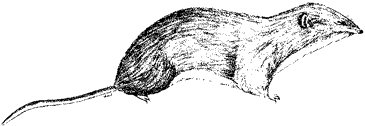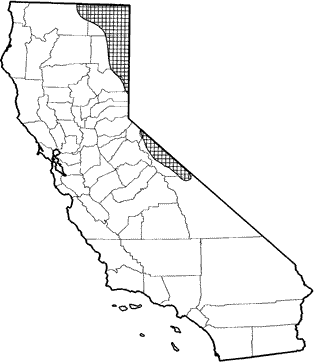
Merriam's Shrew
Distribution, Abundance, and Seasonality
DISTRIBUTION, ABUNDANCEl AND SEASONALITY Merriam's shrew is considered rare throughout its range (Hall 1946, Ingles 1965). In California, it is found in the northeast in Siskiyou, Modoc, Lassen, and Plumas cos., and along the eastern border in Mono and Inyo cos. It is found in pinyon-juniper and sagebrush habitats; less commonly in bitterbrush, low sagebrush, alkali desert scrub, and perennial grass habitats; and rarely in a variety of other habitats of the Great Basin (Hall 1946, Hall and Kelson 1959, Ingles 1965). It has been trapped at elevations ranging from 210 m (650 ft) in Washington (James 1953), to 2900 m (9500 ft) in California (Hoffmann 1955).

Range Map
Specific Habitat Requirements
Feeding: Eats insects and spiders, and mostly caterpillars during summer (Armstrong and Jones 1971). Forages in the burrows of microtine rodents and along their runways (Hooper 1944, Johnson and Clanton 1954, Brown 1967a). Stomach contents included spiders, beetles, cave crickets, caterpillars, and wasps (Johnson and Clanton 1954).
Cover: More frequently found in habitats with perennial bunchgrass understory. Annual grass understory is less desirable (Armstrong and Jones 1971).
Reproduction: Prefers using burrows (Thomas 1979).
Water: Little known. Apparently found in drier areas than other shrews.
Pattern: No data found.
Species Life History
Activity Patterns: No data found. Shrews generally are nocturnal and diurnal, timing activity to prey activity patterns.
Seasonal Movements / Migration: None.
Home Range: No data found.
Territory: No data found.
Reproduction: Breeds from mid-March to mid-July in Washington; no data on peak. Litter size ranges from 5-7 (mean 6) (Armstrong and Jones 1971).
Niche: Predation by owls was observed (Bond 1939, Long and Kerfoot 1963). Parasitized by fleas, nematodes, and cestodes in Washington (Johnson and Clanton 1954).
Sources & References
California Department of Fish and Game, 1999.
California's Wildlife, Sacramento, CA.
Written by: V. Johnson, reviewed by: H. Shellhammer, edited by: R. Duke
Armstrong, D. M., and J. K. Jones, Jr. 1971. Sorex merriami. Mammal. Species No. 2. 2pp. Bond, R. M. 1939. Observations on raptorial birds in the Lava Beds-Tule Lake region of northern California. Condor 41:54-61. Brown, L. N. 1967a. Ecological distribution of six species of shrews and comparison of sampling methods in the central Rocky Mountains. J. Mammal. 48:617-623. Hall, E. R. 1946. Mammals of Nevada. Univ. California Press, Berkeley. 710pp. Hall, E. R., and K. R. Kelson. 1959. The mammals of North America. 2 Vols. The Ronald Press, New York. 1162pp. Hoffmann, R. S. 1955. Merriam shrew in California. J. Mammal. 36:561. Hooper, E. T. 1944. Additional records of the Merriam shrew in Montana. J. Mammal. 25:92. Ingles, L. G. 1965. Mammals of the Pacific states. Stanford Univ. Press, Stanford, CA. 506pp. James, W. B. 1953. The Merriam shrew in Washington State. J. Mammal. 34:121. Johnson, M. L., and C. W. Clanton. 1954. Natural history of Sorex merriami in Washington State. Murrelet 35:1-4. Long, C. A., and W. C. Kerfoot. 1963. Mammalian remains from owl-pellets in eastern Wyoming. J. Mammal. 44:129-131. Thomas, J. W., ed. 1979. Wildlife habitats in managed forests: the Blue Mountains of Oregon and Washington. USDA, For. Serv., Agric. Handb. No. 553. 512pp.
California Animal Facts | California's Wildlife